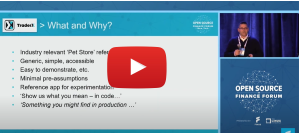What is it?
TraderX is a Sample Trading Application, designed to be a distributed reference application in the financial services domain which can serve as a starting point for experimentation with various techniques and other open source projects. It is designed to be simple and accessible to developers of all backgrounds, with minimal pre-assumptions, and it can serve as a starting point for educational and experimentation purposes. It is designed to be runnable from any developer workstation with minimal assumptions other than Node, Java and Python runtimes. The libraries and toolkits it uses are meant to be as vanilla as possible, to preserve its approachability by developers of all levels.
Why is it important?
TraderX provides a simple, accessible financial-services relevant reference application which may resemble what some organizations have in production today. It can serve as a starting point for introducing new technologies and techniques, illustrating ideas and integrations, and powering hackathons. It's purposefully simple to allow for easy experimentation and learning without requiring a deep understanding of the financial services domain. It can accelerate ideation and prototyping and provide the audience with a familiar context when demonstrating new technologies and techniques.
How does it work?
Learn more about the project - including a brief demo, in the Keynote Demo session that was presented at the Open Source in Finance Forum 2023 
What are the core components?
Database
Self-contained simple SQL database for storing accounts, trades and positions. In this reference implementation for simplicity, this is implemented using H2 database with a TCP server for access from other components in the system.
Account Service
Java/Spring Boot REST service for managing accounts and returning a list of available accounts. This is also used as a form of account validation when handling incoming trade requests.
Position Service
Java/Spring Boot REST service for returning a list of trades and positions (from the database) for a given account to hydrate the blotters when the UI is initially loaded.
Reference Data Service
JavaScript/NestJS REST service for returning a list of valid securities - for populating the UI dropdown for trading, as well as used during validation of incoming trade requests. This is currently consuming from a flat file, but in a production implementation, this would be replaced with a more robust data source.
Trade Service
Java/SpringBoot REST service for accepting new trades. This will perform validation using Account and Reference Data services, and if the trade is valid, it will be published on the trade feed for processing.
Trade Feed
Self-contained SocketIO/NodeJS message bus with a viewer that allows you to see the messages being published and consumed in real-time. Trade processing happens over this message bus (from the trade service and trade processor), and the front-end blotter is updated in real-time via subscription to the account-relevant feed for positions and trades.
Trade Processor
Java/Spring Boot REST service which also consumes messages from the trade feed. It will process the incoming orders/trades, persist in the database and publish updated positions and trade messages back to the trade feed. This is meant to mimic the behavior of trading engines, connecting only to the database and message feeds.
People Service
.NET Core REST service for returning a list of valid users in the system. This is currently consuming from a flat file, and it is used for populating the UI dropdown on the account management page. In a production system this might consume from an LDAP or other user directory/identity management source.
Web Front-End
Angular-based GUI for executing trades, viewing trades and positions, and managing accounts. This connects to all of the REST services mentioned above except for the trade-processor which runs 'headless' and interacts only with the database and message bus.
Ingress Controller
Nginx-based ingress controller for routing traffic to the various services when run in a containerized environment. There is also a similar proxy inside the web-front-end which does this in a lightweight way for local development.